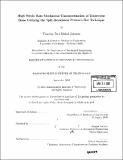High strain rate mechanical characterization of trabecular bone utilizing the split-Hopkinson pressure bar technique
Author(s)
Johnson, Timothy Paul Mahal
DownloadFull printable version (18.16Mb)
Other Contributors
Massachusetts Institute of Technology. Dept. of Mechanical Engineering.
Advisor
Simona Socrate.
Terms of use
Metadata
Show full item recordAbstract
The split-Hopkinson pressure bar (SHPB) technique has been in use in one form or another for more than fifty years and has recently gained a great deal of attention for its ability to characterize materials such as metals, plastics, and even stiff foams at strain rates of up to 105 sec-1. Historically, however, numerous obstacles have stood in the way of applying this technique to softer biological tissues. This study is aimed at bridging this gap by employing various innovations in the field of split-Hopkinson pressure bar techniques (including hollow aluminum and solid polymeric pressure bars) to the characterization of trabecular bone. A preliminary study is conducted on a polyurea (PU) blend to assess the advantages and shortcomings of these approaches, as well as to validate the results obtained with each. Bovine trabecular bone with marrow in-situ, which was chosen for its ability to be tested with a wide spectrum of techniques, is then characterized with the selected techniques at rates of up to 1300 s-1 and strains of 0.07. The results are presented for each technique in the form of engineering stress vs. engineering strain curves. (cont.) Average trend curves are also provided. Unfortunately, many of the samples were too damaged to allow for accurate measurement of apparent density. Consequently, a study into the effect of density on high strain rate responses is left as future work. Recommendations are made for increasing the strain imposed on the samples and suggestions for future studies on both trabecular bone and softer biological tissues are put forward.
Description
Thesis (S.M.)--Massachusetts Institute of Technology, Dept. of Mechanical Engineering, 2005. Includes bibliographical references (p. 185-188).
Date issued
2005Department
Massachusetts Institute of Technology. Department of Mechanical EngineeringPublisher
Massachusetts Institute of Technology
Keywords
Mechanical Engineering.